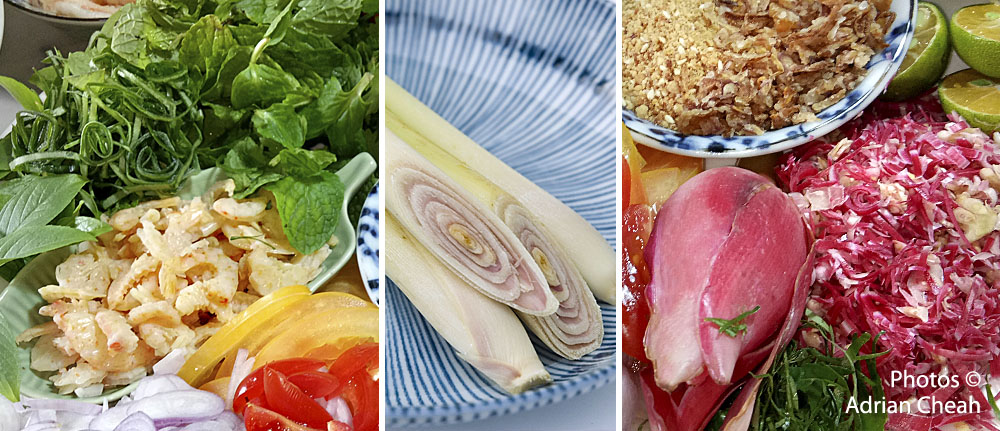The vibrant and colourful Nyonya kerabu bee hoon

When it comes to good food, the only one you have to really satisfy is yourself. When it comes to cooking (without deviating too far from the recipe), you can add whatever you like to your dish and omit all the ingredients that do not tickle your taste buds.
Hawkers in Penang have become used to their rather demanding clientele – not too much chilli, more chilli please, no taugeh (beansprouts), more vegetables, less oily, separate the gravy and the list goes on and on. Obligingly, the hawkers oftentimes fulfil each request without batting an eyelid.

If you are making kerabu bee hoon at home, you get to decide what goes into your dish. Of course, bee hoon (rice vermicelli) is a must and should not be substituted with other types of noodles. All else is left to you. I have divided the ingredients for making Nyonya kerabu bee hoon into three main categories – sambal belacan, aromatic herbs and textural components.
Buy some good sambal belacan from the wet market or your favourite supplier. This will reduce the task of making your own. I will buy the super spicy option. According to the degree of spiciness you fancy, add freshly squeezed calamansi lime juice to a few teaspoons of sambal belacan. Balance the taste with sugar and salt plus a splash of light soy sauce. Add in a good amount of thinly sliced shallots. The crunchy and slightly spicy flavours of the shallots will add drama later to the dish. Remember to toss everything together only when you are ready to serve. Avoid preparing the dish in advance as the shallots and herbs can release a good amount of juices, thus diluting the taste.

Now let us take a closer look at the aromatic herbs. Top of the list is the star ingredient – bunga kantan (torch ginger flower). Finely slice the flower. The aroma from the bunga kantan is distinct and is like no other. Its bright pink shade adds a vibrant touch to this colourful dish. Other herbs to add include lemongrass (use only the bottom white part, minced finely), tender young kaffir lime leaves (remove the spine and slice thinly), mint, coriander, Thai basil leaves and red chillis (sliced thinly).

For the textural components, add dried shrimps (washed, soaked, coarsely pounded and toasted till fragrant), small dried anchovies (rinsed, dried and deep-fried till crispy), kerisik (pan-fried freshly grated coconut till golden), fried shallots and crushed peanuts. The dried shrimps and anchovies will enhance the umami component of the dish. I will usually add finely julienned carrots and some thinly sliced tomatoes for more colour. Some cooks will toss in some julienned cucumber and blanched taugeh.

To make the dish more interesting, I will always add some hard-boiled eggs and large prawns (shelled, deveined and blanched). You can add squid and crab sticks as well. Blanch and season the seafood items with some light soy sauce, oil and white pepper.

Soak the bee hoon for 20 minutes before blanching it for a minute or two. Allow the bee hoon to cool before tossing everything together. I will add some cooking oil to loosen the texture and a dusting of white pepper powder. This is really one recipe where you have to adjust the taste and flavours to your liking!
Although it is not a complicated dish to prepare, it may be difficult to source all the much-needed ingredients if you are not living in Penang. Omit what you cannot find and substitute them with something similar. Instead of sambal belacan, try tom yam paste. Instead of calamansi lime, try other available limes. Just ensure that the amount of bee hoon you used is well balanced with the spicy, tangy, sweetish and umani flavours.
The zesty Nyonya kerabu bee hoon can be enjoyed for breakfast, lunch, dinner or as a snack. There is never a wrong time to savour a plate of this vibrant offering that will awaken all your senses.
-------------------------------------
Written and photographed by Adrian Cheah
© All rights reserved
Updated 14 July 2021